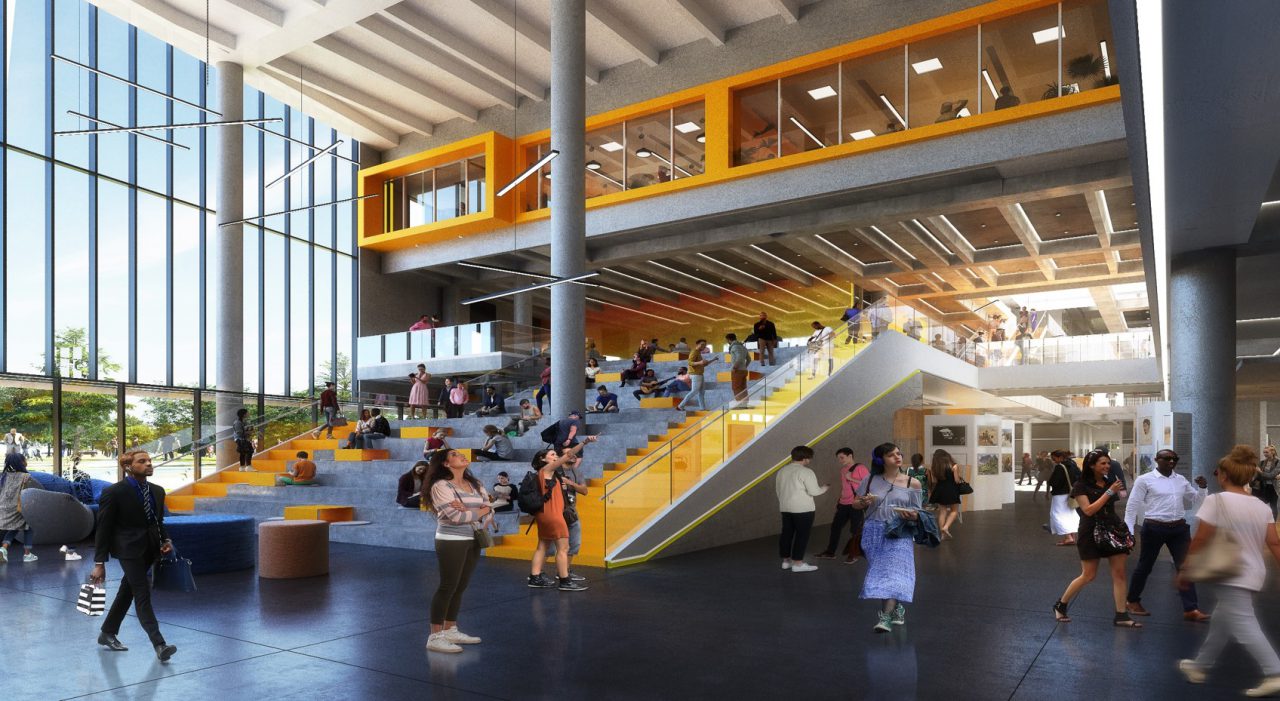This is the third in a series of articles about specific aspects of TCC Northwest’s redevelopment project, part of the $825 million bond program approved by Tarrant County voters in 2019. Other articles will follow periodically as construction moves toward completion in late 2025.
“It’s an ill wind,” the proverb goes, “that blows no good.” To which Jan Clayton would add a hearty “Amen.”
“As has been pointed out,” said TCC Northwest’s vice president for student services, “the unfortunate circumstance of nature has presented good fortune for our campus in terms of facilities.”
Thus, the windstorm that caused severe structural damage to campus buildings in 2016 has led to a redevelopment that includes a new building – NW01 under TCC’s new nomenclature system – that will house many of the functions that most impact students out of the classroom.
Visitors to what has been described as the “front door” of TCC Northwest, will first encounter a front-line assistance desk where they will be directed to whatever services they seek. To their immediate right, along the south face of the building, are the workspaces for success coaches and the private focus rooms where they can consult with and advise students.
To the north, in the center of the east-west wing, will be a waiting area equipped with computers for student use. Financial Aid occupies the far northeast corner, with Business Services and the Registrar’s area to the southwest.
Midway down the east-west wing, north of the assistance desk, is the Student Welcome Center, designed as a focal point for students new to TCC or prospective students and their families. There is a bank of computers and printers for those seeking information, a student life information area dealing with extra-curricular activities and an auditorium where new students can be shown video presentations as part of orientation.
Behind the auditorium is the crown jewel, not only of the building, but perhaps also of the entire campus – the Learning Stair. These structures earned popularity midway in the last decade as places for students to rest, study, snack, meet up, daydream – whatever the moment calls for. They’re wide – Northwest’s is 30 feet across at the bottom and 38 feet at the top. It leads to the second floor, but metaphorically can take students anywhere – to success at TCC, transferring to a university, advancing to a rewarding career – while all the time growing as a person.
“What’s really neat about that feature is that you can think of all the metaphors, all the ways to define success,” Clayton said. “But it’s also an intentional space for students to gather and connect with one another. I think it’s going to invite some energy into that building that will be exciting to see.”
The Learning Stair invites students to look outward in addition to upward. Extending to the west at floor level is a casual study area and a large bank of windows providing a view across Marine Creek Lake. “With this redevelopment, we’ve had to disperse students all across the campus where we can,” Clayton said. “So this is a return to being able to see them in mass and in a spectacular way with that beautiful stairway.”
From the Learning Stair, the building takes a turn southward to the area for Counseling and a Wellness Center, thus joining the services tending to the student’s physical as well as mental well-being. Further down the hall are the Transfer Center, Veterans Services, Stay the Course headquarters and Student Accessibility.
Student Services are so varied that they can’t all fit on the first floor. Testing, Continuing Education, Dual Credit and Student Activities are on the next floor with classrooms and a large space for faculty. The College has elected to move away from private offices for faculty to a collaborative workspace environment with open work spaces and “focus rooms” for use when privacy is essential.
“Higher education didn’t get the stigma of being an ivory tower for nothing,” said Northwest President Zarina Blankenbaker. “What we’re wanting to do is dispel that notion and show that we truly are accessible, we are visible, we are among our students and we are among each other.”
There’s a practical side, as well. “It’s about building for flexibility,” Blankenbaker said. “It’s about building for agility so that if we have to adaptively redesign that space, we don’t have to knock down 16 walls.”
The collaborative workspace model continues on the third floor and is reflected not only in faculty areas, but also in the administrative suite for Blankenbaker and her senior staff. The remainder of the floor is taken up with 10 classrooms and the Student Government Association offices.
With this building, TCC Northwest seems to have achieved the always-sought-after but never-quite-realized “one-stop shop” for student services. Instead of sending students to buildings scattered across a campus, they can be not just directed, but escorted to whatever is needed next. “Absolutely,” said Clayton, “and if we’re doing our job the right was that’s exactly what we’re going to do. We’re going to cross-train ourselves to be able to give those warm handoffs to get students wherever they need to be.”
Clayton tempers her enthusiasm, and those of her Student Services team, with the realization that their new quarters, for all the space and amenities they provide, will not be perfect. “We’re not entering into it with the idea that it’s the solution to everything – magic or whatever,” she said. “We’re going to learn. We’re going to figure some things out, and some things aren’t going to work the way we thought they were.
“But the important thing is that we’re always moving forward with the idea of asking ourselves if we’re doing the best we can for our students and, most important, are the outcomes successful – are the students getting what they need. It’s going to be great, and it’s going to be fun.”

